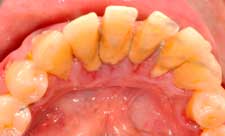Dental plaque is a collection of bacteria and it is colorless, formed and bound to the surface of the teeth, tongue, dentures and strategic places such as margin of fillings, crowns and between the teeth. Plaque is often mistaken as food residues.
Scientifically, this plaque is now known as the dental biofilm. In the plaque is estimated that there are over 1000 species of bacteria . With improvement in technology, more new species of bacteria are found in the dental plaque .
Dental plaque is a complex community of bacteria that clings to a surface in the mouth. Since it is outside the body, the content is not affected by antibiotics, antibacterial agents and immune system of the body. Once it is causing problem to the gum through its present in the tissue and its toxin, then the immune system of the body will be called into action. The complexity and bacterial content of the plaque increases with time, which occurs when plaque is left undisturbed.
|
|
|
Calculus (tartar) is hardened plaque , if it is left undisturbed. Once calculus has formed, it is difficult for brushing and flossing to be effective. Rough surfaces of the calculus cause more plaque to form and accumulated in the area, giving rise to difficulty in cleaning.
In an era of increased knowledge about oral hygiene, the effect of dental plaque is still seen in our society. In the survey done by Oral Health Division, Ministry of Health Malaysia in 2010, it was found that 94% of adults examined suffer from gum disease in various stages of the disease; 88.9% had experienced dental caries; an average of 11.7 teeth have caries per person; 8.0% of people aged over 50 years suffer root caries; 37.9% require tooth extraction and 37.7% require a dental fillings. All these are the results of poor plaque control.
|
|
|
|
Calculus behind the lower front teeth
|
|
What happens if plaque is not removed ?
If plaque are left undisturbed, it can lead to:
- Gum (periodontal) disease – the accumulation of plaque causes gum inflammation and infection. In the early stages of gum disease (gingivitis ), the symptoms such as redness, slight swelling and bleeding is detected. It rarely causes pain. However, if left untreated, gingivitis can lead to more severe gum disease (periodontitis ), which causes damage to the gums and bone supporting the tooth, and may ultimately result in tooth loss. As the gums is part of the body, infection and inflammation of the gums can increase the likelihood of some medical problem such as stroke, lung infections, complications of diabetes and so on.
- Tooth decay (dental caries) – it is a localized damage to tooth structure caused by acids produced from the breakdown of sugar by bacteria in the plaque, and thus a cavity is formed on the tooth. Dental caries is a bacterial infection that may harm the tooth and even the person’s health.
- Bad breath (halitosis ) – the presence of plaque on the teeth , tongue and other surfaces in the mouth can produce toxic substances that emit a foul odor, especially when there is presence of food trapped between the teeth or inside a cavity (caries).
Plaque control to prevent disease
Plaque formed all the time. Generally it is easily removed with good oral hygiene at home:
- Brushes the teeth twice daily, using suitable toothbrush (soft) and proper technique.
- Use dental floss correctly.
- Using other methods of plaque control as recommended by your dentist, such as interdental brush and mouthwash.
When plaque hardened and turns into calculus (tartar), scaling is necessary and should only be done in a dental clinic by a dentist. Therefore, regular visit to the dentist is the best way to prevent the damage that can be done by this dental plaque and calculus .
Reference
- NOHSA 2010
- ten Cate, Jacob M. (2006). “Biofilms, a new approach to the microbiology of dental plaque”. Odontology (Springer Publishing) 94 (1): 1–9.
| Last Reviewed | : | 25 April 2014 |
| Writer | : | Dr. Che Noor Aini bt. Che Omar |
| Dr. Azillah bt. Mohd Ali | ||
| Dr. Chew Yoke Yuen | ||
| Dr. Norrizan bt. Basir | ||
| Dr. Doreyat b. Jemun | ||
| Dr. Sharol Lail b. Sujak | ||
| Accreditor | : | Dr. Rosrahimi bt. Abdul Rahim |
| Reviewer | : | Dr. Ahmad Sharifuddin b. Mohd Asari |











